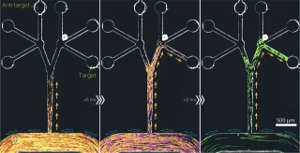Understanding longevity: From gene sequences to social inequity
03 April 2025
Published online 13 August 2021
Tiny inanimate objects moving in response to chemical signals bring opportunities to the oil industry, medicine and materials science.

Todd Squires
Enlarge image
“This is really unprecedented,” says chemical engineer, Todd Squires, of the University of California Santa Barbara, whose group has developed the technology with Amr Abdel-Fattah and colleagues at Saudi Aramco’s EXPEC Advanced Research Center in Dhahran, Saudi Arabia.
The Saudi Aramco researchers have a long-term vision of using the procedure to develop autonomous nano-agents that could find hidden oil trapped in tight pores. Broader possibilities include delivering diagnostic or drug-release agents to specific parts of the body.
There are two aspects to making the objects become mobile targeting agents. First, the target area must naturally release a chemical signal or be made to release one, which then automatically diffuses out from the target region down its concentration gradient.
Next, a mechanism is required to make the targeting object move up the signal’s concentration gradient to reach the target area and accumulate there.
Squires explains that liquid objects, such as discrete oil droplets, move via a process called soluto-capillary migration, in which the chemical signal lowers the surface tension of the region of the droplet closest to the target. “The result is a kind of conveyor belt that makes the droplet pull itself through the fluid towards higher concentrations of the chemical signal,” he says.
A different strategy called diffusiophoresis is used to move solid particles. This relies on the physical diffusion of the signal molecules away from the target propelling the solid particles back towards the target.
The researchers have demonstrated the principle of their concept with trials in a fabricated network with branching channels leading to reservoir regions. Target regions contained the simple alcohol butanol, which acts as the chemical signal. Silicon oil droplets were then found to migrate selectively towards the target region, travelling up the butanol concentration gradient.
Chemical engineer, Howard Stone, of Princeton University, who was not involved in the work, describes the innovation as a “very clever idea”, adding that he expects a wide range of researchers to be interested in it.
The team has a provisional patent pending to cover the procedure as they move beyond this early stage towards real-world applications. In addition to seeking out hidden oil and diagnosing or treating disease, Squires says possibilities include tuning the properties of specific regions in smart coatings.
doi:10.1038/nmiddleeast.2021.69
Tan, H. et al. A two-step strategy for delivering particles to targets hidden within microfabricated porous media. Sci. Adv. 7, eabh0638 (2021).
Stay connected: